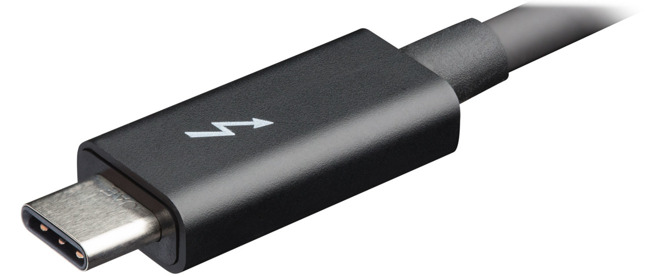Intel details Thunderbolt 4 spec, but 'Apple silicon' support is unclear [u]
Intel on Wednesday announced new details about its upcoming Thunderbolt 4 standard, though compatibility with Apple silicon Macs remains to be seen.

Credit: Intel
The Thunderbolt 4 standard will be backward compatible with previous Intel ports and cables, and will also be cross-compatible with USB4. Compared to Thunderbolt 3, it'll offer a number of tangible benefits to consumers while retaining the USB-C connector type.
For example, it'll allow for universal cables up to two meters long without needing to resort to active cables that leave out older USB standards. Thunderbolt 4 will also support accessories, such as docks, with up to four Thunderbolt 4 ports. The standard will double the minimum video and data requirements of Thunderbolt 3.
Other features include the ability to wake up a computer from sleep by touching a peripheral connected to a Thunderbolt dock, and protection against physical DMA attacks.
Thunderbolt 4 will debut on Intel's Tiger Lake Processors for laptops later in 2020. Intel will also make new 8000-series controller chips available to computer and accessory makers.
How Apple silicon Macs are going to implement Thunderbolt support is an open question. The Developer Transition Kit -- essentially a Mac mini with an A12Z -- doesn't come with any Thunderbolt 3 ports, for example.
Intel notes that Thunderbolt 4 requires "Intel VT-d-based direct memory access protection." That suggests that Thunderbolt 4 may require Intel chips or technology to function.
Update: Apple in a statement to AppleInsider said it is committed to the future of Thunderbolt and will support the protocol on Apple silicon Macs.

Credit: Intel
The Thunderbolt 4 standard will be backward compatible with previous Intel ports and cables, and will also be cross-compatible with USB4. Compared to Thunderbolt 3, it'll offer a number of tangible benefits to consumers while retaining the USB-C connector type.
For example, it'll allow for universal cables up to two meters long without needing to resort to active cables that leave out older USB standards. Thunderbolt 4 will also support accessories, such as docks, with up to four Thunderbolt 4 ports. The standard will double the minimum video and data requirements of Thunderbolt 3.
Other features include the ability to wake up a computer from sleep by touching a peripheral connected to a Thunderbolt dock, and protection against physical DMA attacks.
Thunderbolt 4 will debut on Intel's Tiger Lake Processors for laptops later in 2020. Intel will also make new 8000-series controller chips available to computer and accessory makers.
How Apple silicon Macs are going to implement Thunderbolt support is an open question. The Developer Transition Kit -- essentially a Mac mini with an A12Z -- doesn't come with any Thunderbolt 3 ports, for example.
Intel notes that Thunderbolt 4 requires "Intel VT-d-based direct memory access protection." That suggests that Thunderbolt 4 may require Intel chips or technology to function.
Update: Apple in a statement to AppleInsider said it is committed to the future of Thunderbolt and will support the protocol on Apple silicon Macs.

Comments
So, it essentially brings TB capability for PC to Apple Mac levels, almost? 5K monitor support is spotty in the PC world.
https://support.apple.com/guide/security/dma-protections-seca4960c2b5/1/web/1
Why wouldn't Apple just add the controller chip on their motherboards? (And that goes for TB3 as well.)
People REALLY need to stop assuming the Dev Kit mini is what the new Apple Silicon based Macs will be like.
It's hard to imagine how Apple could make it more clear that the Developer Transition Kit does not represent what Apple will be releasing in the fall. The only solution would have been to not talk about it at all or not release the DTK in general--invite only.
I agree most people don’t need this performance and that for low-end users USB3.n is usually adequate.
I think the best thing about this TB4 looks to be the 4-port dock possibility.
Why do people think that PCIe is some difficult controller. Apple implemented PCIe on the G5 back in 2005. I'm pretty sure if Apple could manage PCIe in 2005 they can do the same in 2020.
Required Intel VT-d based DMA protection.
The PCIe 32GB/s means PCIe 4.0 as a minimum. No problem as by the time Apple Silicon on Mac Pro arrives they’ll be PCIe 5.0 based motherboards.
https://newsroom.intel.com/news/introducing-thunderbolt-4-universal-cable-connectivity-everyone/#gs.aasuc3
When It Is Available: Later this year, Intel expects to deliver the new Thunderbolt 4 controller 8000 series, including:
The first computers and accessories with Thunderbolt 4 ports are also expected to be available this year, including laptops based on Intel’s innovation program code-named “Project Athena.”
Apple will include one of those host controllers on their Apple Silicon based Mac motherboards just like AMD OEMs will do to offer TB4 on their motherboards.
What the hell?
It's not any faster?
And in the real world, what's the difference between 'compatible' or 'compliant'?
Compatible --> might work
Compliant --> will work
As far as I can tell, the only new thing is accessories can have 4 TB ports.
People think the A12Z chip is what will be used. haha.
Because of leaks this would not have worked. People don't know how to keep their mouth shut. Also it was announced at WWDC to give developers a head start. It should really be called "conversion kit". Macs will hopefully be "One More Thing" in September.
Right. My error in bit vs. byte, and yes the minimum requirement is PCIe 3.0 bandwidth. In practical application, that means PCIe 4.0 as no Vendor will be producing PCIe 3.0 motherboards any longer, including Apple with Apple Silicon.
I too boot from an external drive on one of my iMacs and for me too more speed, always want more speed.
I recognise I’m not a low-end user and not overly impressed with this TB4 that is no faster than TB3.